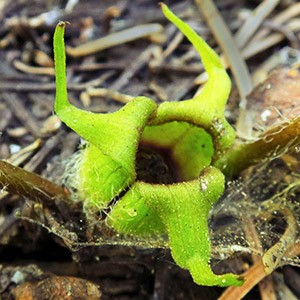Asarum wagneri
Asarum hartwegii
green-flower wild ginger, long-tail wild ginger, wagner's wild ginger
Hartweg's wild ginger
horizontal, ± deeply buried, internodes 0.5-2.1 cm.
erect or ascending, deeply buried, internodes 0.2-1.3 cm.
blade not variegate, broadly reniform to cordate-reniform, 3-8 × 4-11 cm, apex obtuse to rounded (broadly acute);
surfaces abaxially sparsely hirsute, adaxially sparsely hirsute only along veins, marginal hairs mostly curved toward apex.
blade almost always variegate with white or silver along veins, cordate to cordate-reniform, 5.3-10 × 7-14 cm, apex rounded-acute to rounded;
surfaces abaxially appressed-hirsute, usually sparsely so, adaxially glabrous or sparsely hirsute along veins, marginal hairs strongly curved toward apex.
erect or ascending;
peduncle 0.8- calyx tube subglobose to cylindric-urceolate or urceolate, externally light green, sparsely to moderately hirsute, internally white or light green, bordered and occasionally striped with purple, with purple hairs;
distal portion of sepal spreading perpendicularly from base at anthesis, bent abruptly upward at midpoint, 8-20 mm, apex filiform-acuminate, abaxially white to pale green, sparsely villous to villous, adaxially white or light green, at least distally, bordered with purple and occasionally with purple band across base, puberulent with crisped purple-tipped hairs;
pollen sacs 1-2 mm, sterile tip of connective on inner stamens dark red, 0.25-1 mm, shorter than pollen sacs.
erect;
peduncle 1-2.
tube cylindric, externally reddish, sometimes mottled red and green, hirsute, internally white with brownish purple stripes and white hairs (becoming brown with age);
distal portion of sepal usually spreading at anthesis, sometimes reflexed or nearly erect, 12-27 mm, apex filiform-attenuate, abaxially reddish, hirsute, adaxially reddish, puberulent with crisped pale hairs;
pollen sacs 2 mm, sterile tip of connective on inner stamens pale (sometimes dark in dried specimens), 3-5 mm, longer than pollen sacs.
= 26.
Asarum wagneri
Asarum hartwegii
Asarum wagneri is endemic to the Cascade Range of pouthern Oregon (K. L. Lu and M. R. Mesler 1983).
(Discussion copyrighted by Flora of North America; reprinted with permission.)
Asarum hartwegii was confused with A. marmoratum until very recently; reports of A. hartwegii from southern Oregon are errors for A. marmoratum (M. R. Mesler and K. L. Lu 1990).
(Discussion copyrighted by Flora of North America; reprinted with permission.)
